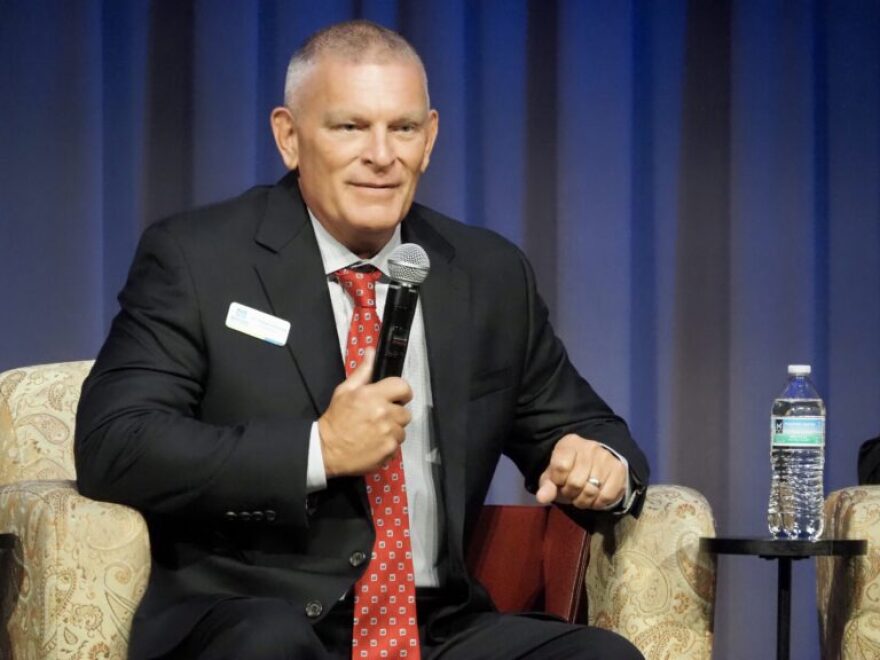OKLAHOMA CITY — Robert Romines is happy to admit he was wrong.
The superintendent of Moore Public Schools didn’t think the Oklahoma Legislature made the right choice when implementing a statewide ban on student cellphones in schools this year. He thought parents would be against it and teachers would spend too much time policing the rule.
“I’m all about eating crow when I have to, and they got this one right,” he said.
Now nine weeks into the school year, Romines said “things have gone really, really well.” Discipline incidents have significantly decreased, he said, and students are more engaged with their teachers and each other.
Students are passing footballs and playing volleyball in high school courtyards during lunch period. Junior high students are playing cards and board games.
“Those are things that we would not have seen last year and in previous years,” he said. “That’s big. I mean, that’s huge. It’s just been a really good thing.”

Senate Bill 139 prohibited student use of personal electronic devices, including cellphones and smart watches, for the entire school day. The law required all public school districts to comply with the full-day ban for the 2025-26 school year. After that, each local school board can decide whether to continue with the policy or try something different.
Romines said he expects Moore to keep the policy next year, though the decision isn’t his to make alone.
He said it’s been helpful that all public schools in the state are under the same cellphone rule, so “parents can’t come back and say, ‘Well, Norman does it this way. Moore does it this way. Mustang does it this way, Edmond does it this way.’” The lack of comparison has helped with acceptance.
In Bartlesville Public Schools, cellphones had become an incessant nuisance in seventh-grade teacher Heather Davis’ classroom.
Davis, in her 32nd year of teaching, remembers when old Nokia cellphones first appeared in her students’ hands, but once personal devices started connecting to social media, “that’s when I saw the uptick in kids checking out of school and checking into their cellphones.”
“It was constant lunch detentions, calls home, sent to the office, all of that,” she said. “And I would say that probably it was a problem for about 30% to 40% of my students.”

That changed dramatically this year with the statewide ban in place. So far, Davis said she’s had to discipline only one student for breaking the rule.
Her school had attempted to crack down on cellphones in the past, but this time, students and their parents have been more willing to comply, knowing the policy comes from a state law, she said.
It’s made a noticeable difference in her English language arts classes, she said. More students are participating, asking questions and completing their work.
“My kids are way more engaged,” Davis said. “I have a lot more students who are passing at this point in the class in the school year.”
Another seventh-grade teacher, Melanie Darter, said the cellphone ban has been a “game changer” at John W. Rex Charter Intermediate School in Oklahoma City.
Students at the school are required to leave their cellphones in their backpacks for the day, said Darter, who teaches science.

“I haven’t seen one yet,” Darter said while speaking at an interim study Tuesday at the state Capitol. “Every once in a while, one will ring in my class, but it’s because it’s in their backpack. And so, I’m like, hey, I don’t even care. It’s away. So, they’re doing really well with that.”
An author of SB 139, Sen. Ally Seifried, R-Claremore, said she hears from educators and parents multiple times a week about the impact of the cellphone ban — stories of extra books being checked out in school libraries and anecdotes of classmates showing more togetherness.
Given the perceived success of the cellphone ban, Seifried and the law’s House author, Rep. Chad Caldwell, R-Enid, are now exploring whether other technology, like Chromebooks, should be limited in schools. They didn’t draw a definitive conclusion during their interim study on the topic Tuesday, but both said they want to continue the conversation.
In the meantime, Caldwell said feedback has been “really, really positive” with SB 139 in effect.
“Just the stories we’ve heard from our educators about the laughter and the conversation that is filling our hallways and our lunchrooms, I think that’s exciting,” he said. “And you take a look at increased learning opportunities and a decrease in behavioral issues, I mean, that is a true win-win. I think it’s a very simple change, but it’s one that’s really having a profound impact on our kids.”



